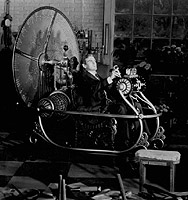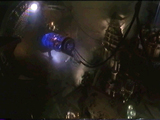 |
<< previous theme
(space travel) | next theme (computers) >>
|
The science behind time travel is highly speculative; therefore, the technology used to travel through time differs greatly from film to film. The form this technology takes is typically aligned with a film's general attitude about science and technology. Special effects are extremely important in any film that attempts to visualize time travel, as viewers can not pull from real-life experiences to help them understand on-screen events.
|
The concept of time travel appeared early in science fiction film. Based in England, Robert Paul and H. G. Wells had plans in 1895 to build a multimedia film theater to simulate time travel, but those plans fell through. Paul did, however, go on to make several films in the nineteen-tens including How to Make Time Fly (1905) (Gunn, 167).
|
Wells' famous time travel novel was later made into a full-length film, and The Time Machine (1960, US) has become one of the best-known science fiction films. In the beginning of the film, a well-conceived explanation of the fourth dimension is given by George, a late Victorian-age scientist/hobbyist who has invented a time machine. This scientific explanation sets the stage for the technology at hand: the time machine. This machine is Victorian in style, fitting in well with the film's overall form.
The experience of time travel in this film is straightforward and has fewer consequences than many other time travel films. One trip is made to the future, and one trip is made back. Time travel in this film is merely a way to get from one point to another, and does not introduce many of the complications found in later films. Travelling forward through time is much like watching a video on fast forward or a time-lapse film, and this effect contributes greatly to the film's success.
|
 |

The Victorian-age time machine. |
|

A time travel experiment being performed on H. |
 |
La Jetee (The Pier) (1962, France) is a short film with many issues surrounding the action of travelling through time, including a time paradox. Time travel is central to this film's events, as the complications that result from it form its plot. Rather than focusing on technology, gadgetry and hard science, this film shows the intense mental pressures that a traveller is subject to when moving through time.
The largest problem with travelling through time is one of mental hardiness; most people simply can not do it, since it is too confusing for the brain. Travelling through time is equivical to being born again in a new time, and brings insanity to those who have not been properly conditioned. Conditioning comes through fixation on and reinforcement of strong memories, such as H's obsession with a memory from his childhood where he watched a man get shot and killed. This memory is evidence of the ultimate time paradox; when H makes his final trip back through time, he is shot and killed -- and sees himself as a child, looking on.
|
|
A paradox is not seen in The Terminator (1984, US), but pre-ordained time travel is -- that is, the known future could not exist without alterations of the past. An assassin robot is sent back in time to kill the mother of a future rebel leader, and a rebel soldier (Reese) is sent back to prevent this from happening. Reese meets up with the woman, and causes her a great deal of confusion by using the past tense when speaking of events from her life that have not yet happened. We see flash-forwards rather than flashbacks, as Reese is remembering the future. He impregnates the woman, becoming the father of the future leader. Although this was not planned by the rebels, the future could not have happened the way it did without this intervention in the past.
|
Pre-ordained time travel, loops in time, time paradoxes, and other side effects of time travel are all seen
in Twelve Monkeys. This film begins in 2035, a time where technology and science are far from perfect.
The scientists try to send Cole back to the year 1996 several times before managing to get him there.
Each time trip taken by Cole involves scenes of
nudity,
blood and
water and ends with his return to the scientists of 2035.
As in La Jetee (the film Twelve Monkeys is based on), travelling through time is an extremely disorienting experience. Divisions between past and present are diminished with each trip, leaving Cole more disjointed and confused. The boundaries between different times disintegrate as the film progresses. Cole eventually loses track of which time is his proper time, which strongly contributes to his mental instability.
Loops in time become apparent as the film progresses. We learn that many of the clues used by the scientists of 2035 to understand and interpret the past were placed by Railly as a result of her association with Cole. She never would have known about the Army of the Twelve Monkeys if Cole had not traveled back in time and met her.
Pre-ordained time travel surrounds Cole's trip through World War I. Railly knows she has seen Cole before when she first meets him, but can't remember where. When she pulls a World War I bullet out of his leg, she remembers that she has seen him in an old war photograph -- that could not have been taken if he had not traveled through time.
The 2035 scientists interact with the past. They own voice mail in 1996, and listen to the recordings in 2035. They then act on the messages by sending people back in time. One message is left by Cole at the end of the film. He tells the future what he is doing, which results in the almost instantaneous appearance of a fellow 2035 inmate, sent by the scientists.
Through these interactions, issues surrounding the potential to change the past are raised. Details from the past are changed as the movie progresses, and these changes are seen in Cole's dreams. The man in the yellow coat from Cole's recurring dream changes from an unknown to Goines when it becomes known that Goines was responsible for the release of the virus. Once this is known, his father is warned, making it impossible for him to do so. At this point, the person in the dream turns into a red-haired man, who finally releases the virus. Although attempts to change the past were made, only the circumstances surrounding particular events changed -- the final outcome is the same. Twelve Monkeys takes the stance that events are inevitable, and changing how an event happens can not ultimately prevent that event from taking place.
|
 |

The time machine used by 2035 scientists. |
|
There are many reprecussions of time travel, and they are explored to varying depths in these films. It is imposible to analyze the validity of any of the speculations made, as the technology to travel through time does not exist -- and perhaps never will.
|
<< previous theme
(space travel) | next theme (computers) >>

Further Resources
(See also the complete references and resources list.)
- Cannon, Damian. "La Jetee," Movie Reviews UK.
http://www.film.u-net.com/Movies/Reviews/Jetee.html (date accessed: 7/1/99)
- Lefcowitz, Eric. "A Brief History of Time Travel," Retro Future. (6/14/99)
http://retrofuture.web.aol.com/timetravel.html (date accessed: 8/1/99)
|
 |


![]()




